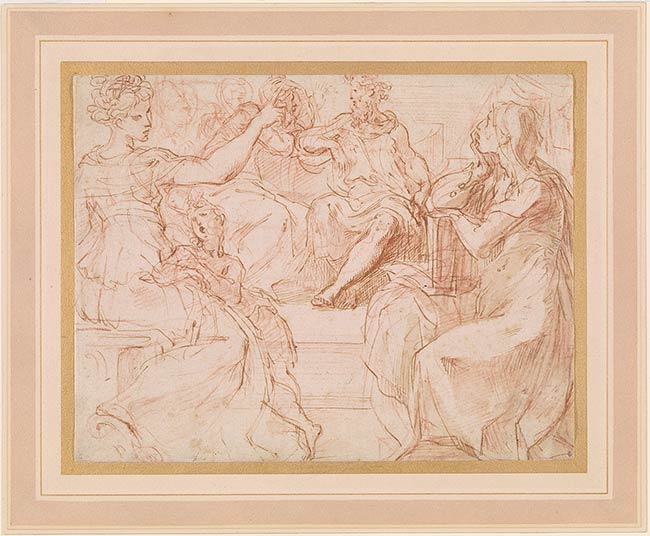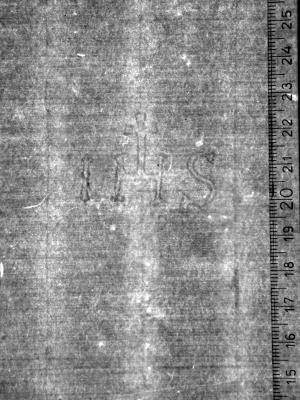
The present drawing is a remarkably fresh study for the seated figures in the lower part of Parmigianino’s composition of the Marriage of the Virgin, which was engraved by Jacopo Caraglio.1 The composition likely dates to Parmigianino’s stay in Rome between late 1523/early 1524 and 1527, and probably more precisely to just before Caraglio’s engraving, which is usually assigned a date of ca. 1526. Parmigianino was influenced by Rosso’s painting of around 1523 of the same subject in San Lorenzo, Florence, which the artist knew, either from seeing it on his journey to Rome or through drawings provided to him by Rosso.2
It has sometimes been assumed that the composition was created specifically for Jacopo Caraglio to engrave, and it is likely that Caraglio based his engraving on the finished study for the composition, which is at Chatsworth, with which it shares very similar dimensions.3 The shape of the drawing has led to the suggestion, however, that the composition originally may have been intended for an altarpiece. This might help to explain the preparatory drawings for small areas of the composition which are still extant.
The Morgan sheet differs from the Chatsworth drawing in the position of the female figure at right, who twists away rather than towards the viewer, extending her right arm, presumably to point at the marriage taking place behind her. A drawing, in red chalk, in the Museo di Capodimonte shows the prophetess almost exactly as she appears in the finished composition, twisted towards the viewer with her hands clasped in front of her breast, but the boy leaning on her lap seems still to be large, as he is in the Morgan drawing.4 Parmigianino also seems to have softened the viewpoint into the composition from this earlier stage in the composition so that the viewer looked in at the Marriage from the same level rather than from below, as in the Morgan sheet.
Two other drawings at the Morgan may be related to the Marriage of the Virgin composition: a sketch, in pen and brown ink, for the Virgin, Joseph, and the High Priest, and another sheet, which may relate to the upper right of the composition, behind the Virgin, where there is a figure with arms folded across the chest.5 There is a copy of the composition in the Louvre.6 David Ekserdjian owns a copy of a lost earlier design (from Peter Lely’s collection), which shows that Parmigianino only came back to Rosso’s balanced composition after an initial conception that was very asymmetrical. A full-scale drawing, once with Hans Calmann, cannot be accepted as by the hand of the master.
David Ekserdjian recently suggested that the pointing figure on the right of the drawing inspired the corresponding figure in Giorgio Vasari’s painting of the Presentation of Christ in the Museo di Capodimonte, Naples (email to Morgan curators, 2010).7
According to A. E. Popham, the watermark appears on drawings by Correggio and on some early drawings by Parmigianino, including the Morgan sheet, inv. I, 46b, mentioned above.
Footnotes:
- The Illustrated Bartsch, 28: 77, no. 1.
- Franklin 1994, 95.
- The Devonshire Collection, Chatsworth, inv. 339; Jaffé 1994, 244, no. 677.
- Museo di Capodimonte, Naples, inv. 703; Popham 1971, 1: 117, no. 290.
- Morgan Library & Museum, New York, inv. I, 46b; I, 46a.
- Louvre, Paris, inv. 6543.
- For the fresco, see Corti, 1989, 53.
Study for the figures in the lower part of the composition engraved by Jacopo Caraglio.
Inscribed at upper center, in pen and brown ink, "54".
Watermark: Letters "IHS" with a cross rising from crossbar of letter "H" (Christogram). Cf. Briquet 9462.
Denon, Vivant, 1747-1825, former owner.
Murray, Charles Fairfax, 1849-1919, former owner.
Morgan, J. Pierpont (John Pierpont), 1837-1913, former owner.
Selected references: Fairfax Murray 1905-12, 1: no. 48; Antal 1928, 52; Copertini 1932, 55, note 27; Quintavalle 1948, 196; Copertini 1949, 13; Freedberg 1950, 65, 174; Popham 1952, 58, under no. 26; Washington and elsewhere 1962-63, 25, under no. 42; New York 1965-66, 59, no. 92; Popham 1971, 1:122-23, no. 312; Providence 1973, no. 34; Los Angeles 1976, 74, no. 84; Jaffé 1994, 244, under no. 677; Gnann 1996, 362, note 9; Gnann 2000, 70; Bambach, in London and New York 2000-2001, no. 77; Chiusa 2001, 213; Ekserdjian 2006, 216; Gnann 2007, 412, no. 399; New York 2007, 15.
Charles Fairfax Murray, Collection of Drawings by the Old Masters formed by C. Fairfax Murray (J. Pierpont Morgan Collection), 4 vols, London 1905-1912, vol. 1, no. 48.
Frederick Antal, "Un capolavoro inedito del Parmigianino," Pinacotheca 1, 1928, p. 52.
G. Copertini, Il Parmigianino, 2 vols., Parma, 1932, p. 55, note 27.
Armando Ottaviano Quintavalle, Il Parmigianino, Milan, 1948, p. 196.
Sydney J. Freedberg, Parmigianino: His Works in Painting, Cambridge, 1950, pp. 65, 174, repr. fig. 40.
A.E. Popham, The Drawings of Parmigianino, London, 1953, p. 58, under no. 26.
A.E. Popham, Old Master Drawings from Chatsworth. A Loan Exhibition from the Devonshire Collection Circulated by the Smithsonian Institution, exh. cat., National Gallery of Art, Washington; Pierpont Morgan Library, New York; Museum of Fine Arts, Boston; Cleveland Museum of Art, Cleveland; National Gallery of Canada, Ottawa; Art Institute of Chicago; and California Palace of the Legion of Honor, San Francisco, 1962-63, p. 25, under no. 42.
Jacob Bean and Felice Stampfle, Drawings from New York Collections, I: The Italian Renaissance, exh. cat., Metropolitan Museum of Art and The Pierpont Morgan Library, New York, 1965, p. 59, no. 92, repr.
A. E. Popham, Catalogue of the Drawings of Parmigianino, 3 vols, New Haven, 1971, vol. 1, pp. 122-23, no. 312; vol. 2, repr. pl. 142.
Janetta R. Benton et al., Drawings and Prints of the First Maniera 1515-1535, exh. cat., Department of Art, Brown University at Museum of Art, Rhode Island School of Design, Providence, 1973, no. 34, repr.
Ebria Feinblatt, Old Master Drawings from American Collections, exh. cat., Los Angeles County Museum of Art, Los Angeles, 1976, p. 74, no. 84.
Michael Jaffé, The Devonshire Collection of Italian Drawings: Bolognese and Emilian Schools, London, 1994, p. 244, under no. 677.
Achim Gnann, "Projekte für die Cesi-Kapelle in S. Maria della Pace in Rom," Zeitschrift für Kunstgeschichte 59, no. 3 (1996), p. 362, note 9.
Hugo Chapman and Carmen C. Bambach, Drawings of Correggio and Parmigianino in English and American Collections, exh. cat., British Museum, London, and the Metropolitan Museum of Art, New York, 2000-2001, no. 77, repr.
Maria Cristina Chiusa, Parmigianino, with register of documents compiled by Marzio Dall'Acqua, Milan, 2001, p. 213.
Achim Gnann, "Per una cronologia dei disegni romani di Parmigianino," Quaderni del Palazzo Te 7 (2000), p. 70, note 62.
David Ekserdjian, Parmigianino, New Haven and London, 2006, p. 216.
Isabelle Dervaux, Drawing Connections: Baselitz, Kelly, Penone, Rockburne, and the Old Masters, exh. cat., Morgan Library & Museum, New York, 2007, pp. 15, 18, repr.

